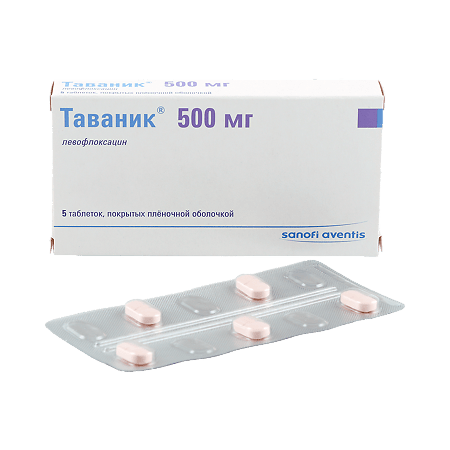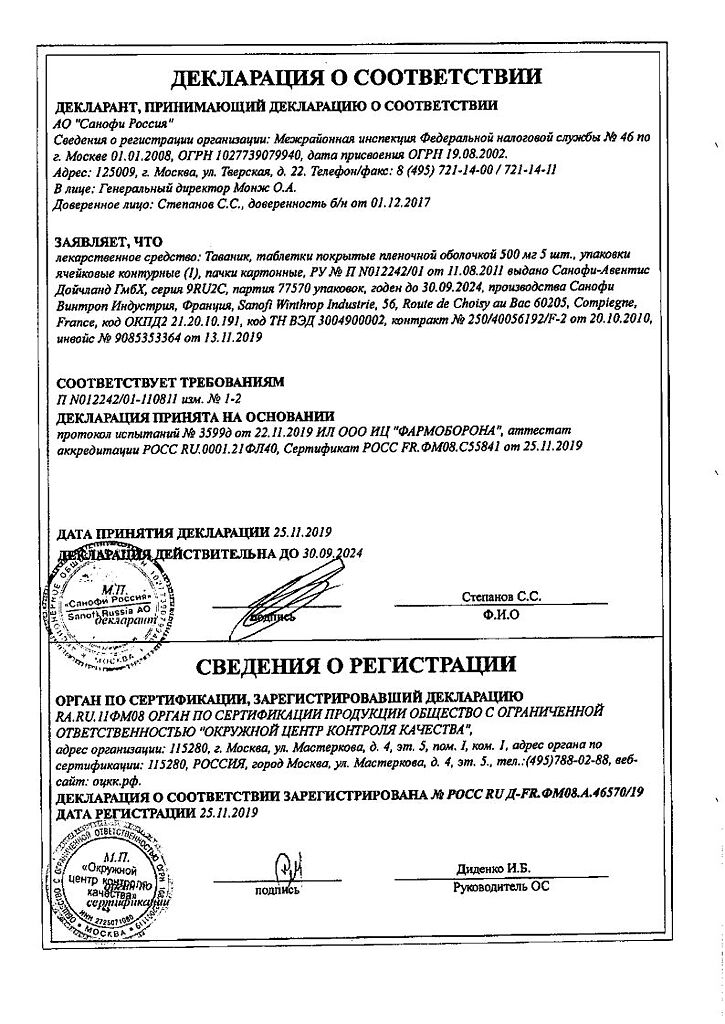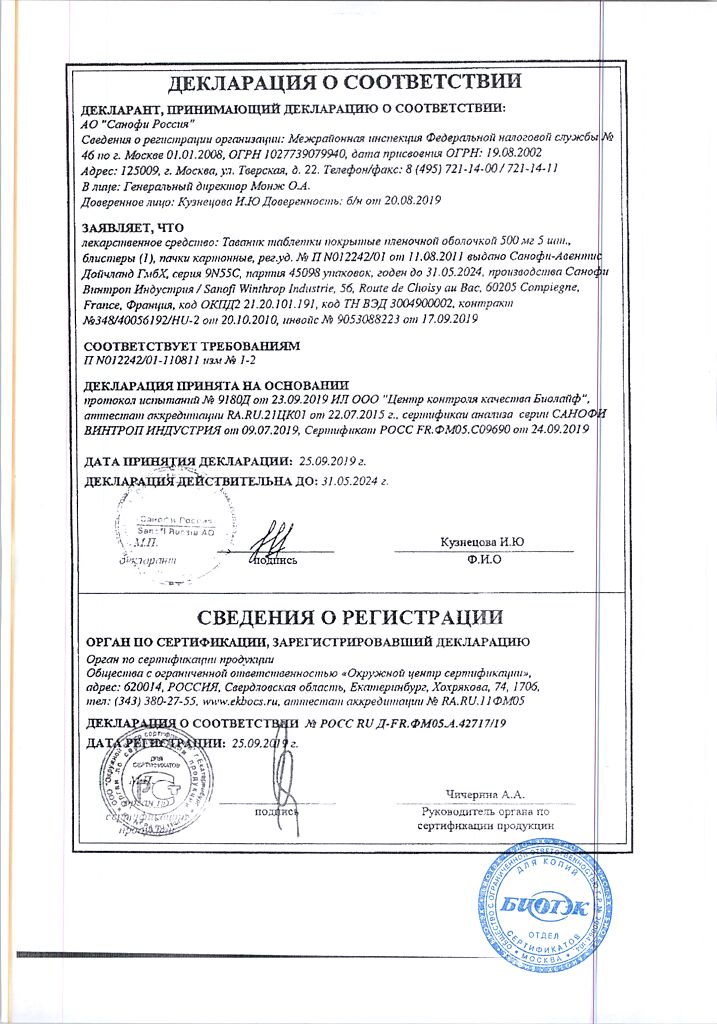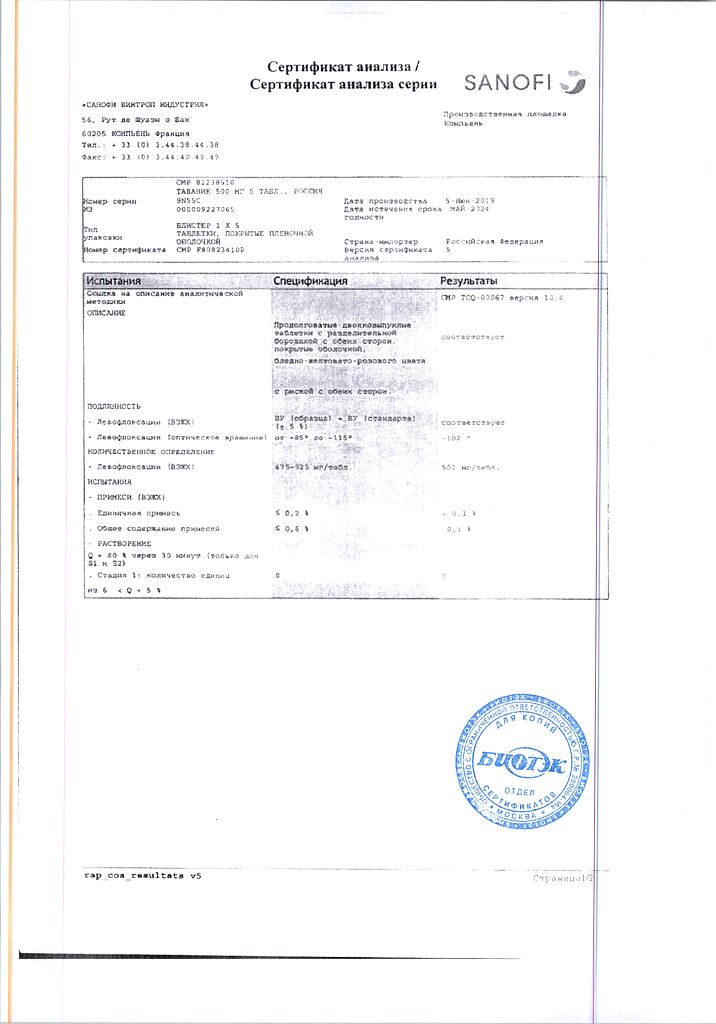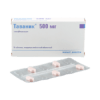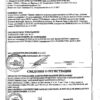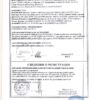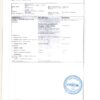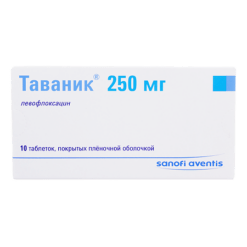No products in the cart.
Description
Pharmacotherapeutic group: antimicrobial agent, fluoroquinolone.
The ATX classification code is J01MA12.
Pharmacological action
Pharmacodynamics
Tavanic is a synthetic broad-spectrum antibacterial drug from the group of fluoroquinolones containing levofloxacin as the active substance – the left-handed isomer ofloxacin.
Levofloxacin blocks DNA gyrase (topoisomerase II) and topoisomerase IV, disrupts superspiralization and cross-linking of DNA breaks, inhibits DNA synthesis and causes deep morphological changes in cytoplasm, cell wall and membranes.
Levofloxacin is active against most strains of microorganisms under both in vitro and in vivo conditions.
- In vitro:
- Sensitive microorganisms (MAC ≤2 mg/mL)
- Aerobic gram-positive microorganisms: Corynebacterium diphtheriae, Enterococcus faecalis, Enterococcus spp, Listeria monocytogenes, Staphylococcus coagulase-negative methi-S(I) [methicillin-sensitive (methicillin-moderately sensitive)] , Staphylococcus aureus methi-S, Staphylococcus epidermidis methi-S, Staphylococcus spp (CNS), Staphylococcus spp (CNS), Streptococci groups C and G, Streptococcus agalactiae, Streptococcus pneumoniae peni I/S/R (penicillin-sensitive/ moderately sensitive/resistant), Streptococcus pyogenes, Viridans streptococci peni-S/Rbr>
Aerobic gram-negative microorganisms: Acinetobacter baumannil, Acinetobacter spp, Actinobacillus actinomycetemcomitans, Citrobacter freundii, Eikenella corrodens, Enterobacter aerogenes, Enterobacter agglomerans, Enterobacter cloacae, Enterobacter spp, Escherichia coli, Gardnerella vaginalis, Haemophilus ducreyi, Haemophilus influenzae ampi-S/R (ampicillin-sensitive/resistant), Haemophilus parainfluenzae, Helicobacter pylori, Klebsiella oxytoca, Klebsiella pneumoniae, Klebsiella spp, Moraxela catarrhalis β+/β-, Morganella morganii, Neisseria gonorrhoeae pop PPNG/PPNG, Neisseria meningitidis, Pasteurella conis, Pasteurella dagmatis, Pasteurella multocida, Pasteurella spp, Proteus mirabilis, Proteus vulgaris, Providencia rettgeri, Providencia stuartii, Providencia spp, Pseudomonas aeruginosa, Pseudomonas spp, Salmonella spp, Serratia marcescens, Serratia spp.Anaerobic microorganisms: Bacteroides fragilis, Bifidobacterium spp, Clostridium perfringens, Fusobacterium spp, Peptostreptococcus, Propionibacterum spp, Veilonella spp.
Other microorganisms: Bartonella spp, Chlamydia pneumoniae, Chlamydia psittaci, Chlamydia trachomatis, Legionella pneumophila, Legionella spp, Mycobacterium spp, Mycobacterium leprae, Micobacterium tuberculosis, Mycoplasma hominis, Mycoplasma pneumoniae, Ricketsia spp, Ureaplasma urealyticum.
Levofloxacin is moderately active (MPC >4 mg/L):
Aerobic gram-positive microorganisms: Corynebacterium urealiticum, Corynebacterium xerosis, Enterococcus faecium, Staphylococcus epidermidis methi-R (methicillin-resistant), Staphylococcus haemolyticus methi-R
Aerobic gram negative microorganisms: Burkholderia cepacia, Campilobacter jejuni/coli
Anaerobic microorganisms: Bacteroides thetaiotaomicron, Bacteroides vulgatus, Bacteroides ovaius, Prevotella spp, Porphyromonas spp.
Levofoloxacin resistant (MPC >8 mg/L):
Aerobic gram-positive microorganisms: Corynebacterium jeikeium, Staphylococcus aureus methi-R, Staphylococcus coagulase-negative methi-R
Aerobic gram negative microorganisms: Alcaligenes xylosoxidans
Other microorganisms: Mycobacterium avium.
Pharmacokinetics
Levofloxacin is quickly and almost completely absorbed after oral administration. Food intake has little effect on the speed and completeness of absorption. The bioavailability of 500 mg of levofloxacin after oral administration is almost 100%. After a single dose of 500 mg of levofloxacin the maximum concentration is 5.2-6.9 mcg/ml, the maximum time is 1.3 h, the elimination half-life is 6-8 h.
The binding to plasma proteins is 30-40%. It penetrates into organs and tissues: lungs, mucous membrane of bronchi, sputum, urogenital organs, bone tissue, cerebrospinal fluid, prostate, polymorphonuclear leukocytes, alveolar macrophages.
In the liver a small part is oxidized and/or deacetylated. It is excreted from the body mainly by the kidneys by glomerular filtration and tubular secretion. After oral administration, approximately 87% of the administered dose is excreted unchanged in the urine within 48 hours. Less than 4% is detected in the feces over a period of 72 hours.
Indications
Indications
Treatment of infectious and inflammatory diseases caused by microorganisms sensitive to levofloxacin:
– community-acquired pneumonia;
– complicated urinary tract infections and pyelonephritis;
– chronic bacterial prostatitis;
– infections of the skin and soft tissues;
– for complex treatment of drug-resistant forms of tuberculosis;
– prevention and treatment of anthrax through airborne droplets.
For the treatment of the following infectious and inflammatory diseases, levofloxacin can be used as an alternative to other antimicrobial drugs:
– acute sinusitis;
– exacerbation of chronic bronchitis;
– uncomplicated cystitis.
When using the drug Tavanic®, you should take into account the official
national guidelines for proper use
antibacterial drugs, as well as the sensitivity of pathogenic
microorganisms in a particular country (see section “Special instructions”).
Pharmacological effect
Pharmacological effect
Pharmacotherapeutic group: antimicrobial agent, fluoroquinolone.
ATX classification code – J01MA12.
Pharmacological action
Pharmacodynamics
Tavanic is a synthetic broad-spectrum antibacterial drug from the group of fluoroquinolones, containing levofloxacin, the levorotatory isomer of ofloxacin, as an active substance.
Levofloxacin blocks DNA gyrase (topoisomerase II) and topoisomerase IV, disrupts supercoiling and cross-linking of DNA breaks, inhibits DNA synthesis, and causes profound morphological changes in the cytoplasm, cell wall and membranes.
Levofloxacin is active against most strains of microorganisms both in vitro and in vivo.
In vitro:
Sensitive microorganisms (MIC ≤2 mg/ml)
Aerobic gram-positive microorganisms: Corynebacterium diphtheriae, Enterococcus faecalis, Enterococcus spp, Listeria monocytogenes, Staphylococcus coagulase-negative methi-S(I) [methicillin-sensitive (methicillin-moderately sensitive)], Staphylococcus aureus methi-S, Staphylococcus epidermidis methi-S, Staphylococcus spp (CNS), Staphylococcus spp (CNS), Streptococci groups C and G, Streptococcus agalactiae, Streptococcus pneumoniae peni I/S/R (penicillin-sensitive/-moderately sensitive/-resistant), Streptococcus pyogenes, Viridans streptococci peni-S/R
Aerobic gram-negative microorganisms: Acinetobacter baumannil, Acinetobacter spp, Actinobacillus actinomycetemcomitans, Citrobacter freundii, Eikenella corrodens, Enterobacter aerogenes, Enterobacter agglomerans, Enterobacter cloacae, Enterobacter spp, Escherichia coli, Gardnerella vaginalis, Haemophilus ducreyi, Haemophilus influenzae ampi-S/R (ampicillin-sensitive/-resistant), Haemophilus parainfluenzae, Helicobacter pylori, Klebsiella oxytoca, Klebsiella pneumoniae, Klebsiella spp, Moraxela catarrhalis β+/β-, Morganella morganii, Neisseria gonorrhoeae non PPNG/PPNG, Neisseria meningitidis, Pasteurella conis, Pasteurella dagmatis, Pasteurella multocida, Pasteurella spp, Proteus mirabilis, Proteus vulgaris, Providencia rettgeri, Providencia stuartii, Providencia spp, Pseudomonas aeruginosa, Pseudomonas spp, Salmonella spp, Serratia marcescens, Serratia spp.
Anaerobic microorganisms: Bacteroides fragilis, Bifidobacterium spp, Clostridium perfringens, Fusobacterium spp, Peptostreptococcus, Propionibacterum spp, Veilonella spp.
Other microorganisms: Bartonella spp, Chlamydia pneumoniae, Chlamydia psittaci, Chlamydia trachomatis, Legionella pneumophila, Legionella spp, Mycobacterium spp, Mycobacterium leprae, Micobacterium tuberculosis, Mycoplasma hominis, Mycoplasma pneumoniae, Ricketsia spp, Ureaplasma urealyticum.
Levofloxacin is moderately active (MIC >4 mg/l):
Aerobic gram-positive microorganisms: Corynebacterium urealiticum, Corynebacterium xerosis, Enterococcus faecium, Staphylococcus epidermidis methi-R (methicillin-resistant), Staphylococcus haemolyticus methi-R
Aerobic gram-negative microorganisms: Burkholderia cepacia, Campilobacter jejuni/coli
Anaerobic microorganisms: Bacteroides thetaiotaomicron, Bacteroides vulgatus, Bacteroides ovaius, Prevotella spp, Porphyromonas spp.
Resistant to levofoloxacin (MIC >8 mg/l):
Aerobic gram-positive microorganisms: Corynebacterium jeikeium, Staphylococcus aureus methi-R, Staphylococcus coagulase-negative methi-R
Aerobic gram-negative microorganism: Alcaligenes xylosoxidans
Other microorganisms: Mycobacterium avium.
Pharmacokinetics
Levofloxacin is rapidly and almost completely absorbed after oral administration. Food intake has little effect on the speed and completeness of absorption. The bioavailability of 500 mg levofloxacin after oral administration is almost 100%. After taking a single dose of 500 mg of levofloxacin, the maximum concentration is 5.2-6.9 mcg/ml, the maximum time is 1.3 hours, the half-life is 6-8 hours.
Communication with plasma proteins – 30-40%. Penetrates well into organs and tissues: lungs, bronchial mucosa, sputum, genitourinary organs, bone tissue, cerebrospinal fluid, prostate gland, polymorphonuclear leukocytes, alveolar macrophages.
In the liver, a small portion is oxidized and/or deacetylated. It is excreted from the body primarily by the kidneys by glomerular filtration and tubular secretion. After oral administration, approximately 87% of the dose taken is excreted unchanged in the urine within 48 hours. Less than 4% was detected in stool over a 72-hour period.
Special instructions
Special instructions
Tavanic should not be used to treat children and adolescents due to the likelihood of damage to articular cartilage.
When treating elderly patients, it should be borne in mind that patients in this group often suffer from impaired renal function (see section “Method of administration and dosage”)
For very severe pneumonia caused by pneumococci, Tavanic may not provide the optimal therapeutic effect. Nosocomial infections caused by certain pathogens (P. aeruginosa) may require combination treatment.
During treatment with Tavanic, seizures may develop in patients with previous brain damage caused, for example, by a stroke or severe trauma. Convulsive readiness may also increase with the simultaneous use of fenbufen, similar non-steroidal anti-inflammatory drugs or theophylline (see “Interactions”).
Despite the fact that photosensitivity is observed very rarely with the use of levofloxacin, in order to avoid it, patients are not recommended to be exposed unnecessarily to strong solar or artificial ultraviolet radiation (for example, exposure to the sun in high mountains or visiting a solarium).
If pseudomembranous colitis is suspected, Tavanik should be discontinued immediately and appropriate treatment should be initiated. In such cases, drugs that inhibit intestinal motility should not be used.
Rarely observed with the use of Tavanic, tendinitis (primarily inflammation of the Achilles tendon) can lead to tendon rupture. Elderly patients are more prone to tendinitis. Treatment with corticosteroids (“cortisone drugs”) appears to increase the risk of tendon rupture. If tendonitis is suspected, treatment with Tavanic should be stopped immediately and appropriate treatment of the affected tendon should be initiated, for example by resting it (see “Contraindications” and “Side Effects”).
Patients with glucose-6-phosphate dehydrogenase deficiency (an inherited metabolic disorder) may respond to fluoroquinolones by destroying red blood cells (hemolysis). In this regard, treatment of such patients with levofloxacin should be carried out with great caution.
Side effects of Tavanic, such as dizziness or stupor, drowsiness and visual disturbances (see also the section “Side effects”), can impair reactivity and the ability to concentrate. This may pose a certain risk in situations where these abilities are of particular importance (for example, when driving a car, when servicing machines and mechanisms, when performing work in an unstable position). This is especially true when the drug interacts with alcohol.
Active ingredient
Active ingredient
Levofloxacin
Composition
Composition
1 tablet contains:
Active ingredient:
levofloxacin 500 mg;
Excipients:
crospovidone;
methylhydroxypropylcellulose;
MCC;
sodium stearyl fumarate;
macrogol 8000;
talc;
titanium dioxide (E171);
iron oxide red (E172);
iron oxide yellow (E172).
Contraindications
Contraindications
hypersensitivity to levofloxacin or other quinolones;
epilepsy;
tendon lesions due to previous treatment with quinolones;
childhood and adolescence (up to 18 years);
pregnancy;
lactation period.
The drug should be used with caution in the elderly due to the high likelihood of a concomitant decrease in renal function (glucose-6-phosphate dehydrogenase deficiency).
Side Effects
Side Effects
From the heart: rarely – sinus tachycardia, palpitations; unknown frequency (post-marketing data) – prolongation of the QT interval, ventricular arrhythmias, ventricular tachycardia, ventricular tachycardia of the “pirouette” type, which can lead to cardiac arrest (see “Overdose”, “Special instructions”).
From the blood and lymphatic system: uncommon – leukopenia (decreased number of leukocytes in peripheral blood), eosinophilia (increased number of eosinophils in peripheral blood); rarely – neutropenia (decreased number of neutrophils in peripheral blood), thrombocytopenia (decreased number of platelets in peripheral blood); unknown frequency (post-marketing data) – pancytopenia (decrease in the number of all formed elements in the peripheral blood), agranulocytosis (absence or sharp decrease in the number of granulocytes in the peripheral blood), hemolytic anemia.
From the nervous system: often – headache, dizziness; infrequently – drowsiness, tremor, dysgeusia (taste perversion); rarely – paresthesia, convulsions (see “Special Instructions”); unknown frequency (post-marketing data) – peripheral sensory neuropathy, peripheral sensorimotor neuropathy (see “Special Instructions”), dyskinesia, extrapyramidal disorders, ageusia (loss of taste), parosmia (disorder of the sense of smell, especially the subjective sensation of an objectively absent smell), including loss of smell, syncope, benign intracranial hypertension.
On the part of the organ of vision: very rarely – visual disturbances, such as blurriness of the visible image; unknown frequency – transient vision loss.
From the organ of hearing and labyrinthine disorders: infrequently – vertigo (a feeling of deviation or spinning of one’s own body or surrounding objects); rarely – ringing in the ears; unknown frequency (post-marketing data) – hearing loss, hearing loss.
From the respiratory system, chest and mediastinal organs: infrequently – shortness of breath; unknown frequency (post-marketing data) – bronchospasm, allergic pneumonitis.
From the gastrointestinal tract: often – diarrhea, vomiting, nausea; infrequently – abdominal pain, dyspepsia, flatulence, constipation; unknown frequency (post-marketing data) – hemorrhagic diarrhea, which in very rare cases may be a sign of enterocolitis, including pseudomembranous colitis (see “Special Instructions”), pancreatitis.
From the kidneys and urinary tract: infrequently – increased concentration of creatinine in the blood serum; rarely – acute renal failure (for example, due to the development of interstitial nephritis).
From the skin and subcutaneous tissues: infrequently – rash, itching, urticaria, hyperhidrosis; unknown frequency (post-marketing data) – toxic epidermal necrolysis, Stevens-Johnson syndrome, exudative erythema multiforme, photosensitivity reactions (increased sensitivity to solar and UV radiation) (see “Special Instructions”), leukocytoclastic vasculitis, stomatitis. Reactions from the skin and mucous membranes can sometimes develop even after taking the first dose of the drug.
From the musculoskeletal system and connective tissue: infrequently – arthralgia, myalgia; rarely – tendon damage, including tendonitis (for example, Achilles tendon), muscle weakness, which can be especially dangerous in patients with pseudoparalytic myasthenia gravis (see “Special Instructions”); unknown frequency (post-marketing data): rhabdomyolysis, tendon rupture (eg Achilles tendon). This side effect can be observed within 48 hours after the start of treatment and can be bilateral in nature (see also section “Special Instructions”), ligament rupture, muscle rupture, arthritis.
From the side of metabolism and nutrition: infrequently – anorexia; rarely – hypoglycemia, especially in patients with diabetes mellitus (possible signs of hypoglycemia: voracious appetite, nervousness, perspiration, trembling); unknown frequency – hyperglycemia, hypoglycemic coma (see “Special Instructions”).
Infectious and parasitic diseases: infrequently – fungal infections, development of resistance of pathogenic microorganisms.
From the side of blood vessels: rarely – decreased blood pressure.
General disorders: infrequently – asthenia; rarely – pyrexia (fever); unknown frequency – pain (including pain in the back, chest and limbs).
From the immune system: rarely – angioedema; unknown frequency (post-marketing data) – anaphylactic shock, anaphylactoid shock.
Anaphylactic and anaphylactoid reactions can sometimes develop even after taking the first dose of the drug.
From the liver and biliary tract: often – increased activity of liver enzymes in the blood (for example ALT, AST), increased activity of alkaline phosphatase and GGT; infrequently – increased concentration of bilirubin in the blood; unknown frequency (post-marketing data) – severe liver failure, including cases of acute liver failure, sometimes fatal, especially in patients with a severe underlying disease (for example, patients with sepsis) (see “Special Instructions”), hepatitis, jaundice.
From the mental side: often – insomnia; infrequently – feeling of restlessness, anxiety, confusion; rarely – mental disorders (for example, hallucinations, paranoia), depression, agitation (excitement), sleep disturbances, nightmares; unknown frequency (post-marketing data) – mental disorders with behavioral disorders with self-harm, including suicidal thoughts and suicide attempts.
Other possible undesirable effects that apply to all fluoroquinolones: very rarely – attacks of porphyria (a very rare metabolic disease) in patients already suffering from this disease.
Interaction
Interaction
There are reports of a pronounced decrease in the threshold of convulsive readiness with the simultaneous use of quinolones and substances that can, in turn, reduce the cerebral threshold of convulsive readiness. This also applies equally to the simultaneous use of quinolones and theophylline, fenbufen or similar non-steroidal anti-inflammatory drugs (drugs for the treatment of rheumatic diseases).
The effect of the drug Tavanik expression is weakened by the simultaneous use of sucralfate (a drug for protecting the gastric mucosa). The same thing happens with the simultaneous use of magnesium- or aluminum-containing antacids (drugs for the treatment of heartburn and gastralgia), as well as iron salts (drugs for the treatment of anemia). Tavanic should be taken at least 2 hours before or 2 hours after taking these medications. No interaction was detected with calcium carbonate. Taking glucocorticosteroids increases the risk of tendon rupture.
When using vitamin K antagonists simultaneously, monitoring of the blood coagulation system is necessary.
The elimination (renal clearance) of levofloxacin is slightly slowed down by the action of cimetidine and probenecid. It should be noted that this interaction has virtually no clinical significance. However, with the simultaneous use of drugs such as probenecid and cimetidine, which block a certain excretion pathway (tubular secretion), treatment with levofloxacin should be carried out with caution. This applies primarily to patients with limited renal function.
Levofloxacin slightly increases the half-life of cyclosporine.
Taking glucocorticosteroids increases the risk of tendon rupture.
Overdose
Overdose
Symptoms: Based on data obtained from toxicological studies conducted in animals, the most important expected symptoms of an acute overdose of Tavanic® are central nervous system symptoms (impaired consciousness, including confusion, dizziness and convulsions).
During post-marketing use of the drug in overdose, CNS effects have been observed, including confusion, convulsions, hallucinations and tremor.
Nausea and erosions of the gastrointestinal mucosa may develop.
In clinical and pharmacological studies conducted with doses of levofloxacin exceeding therapeutic levels, prolongation of the QT interval was shown.
Treatment: in case of overdose, careful monitoring of the patient is required, including ECG monitoring. Treatment is symptomatic. In case of acute overdose of Tavanic® tablets, gastric lavage and administration of antacids are indicated to protect the gastric mucosa.
Levofloxacin is not eliminated by dialysis (hemodialysis, peritoneal dialysis and continuous ambulatory peritoneal dialysis). There is no specific antidote.
Storage conditions
Storage conditions
At a temperature not exceeding 25 °C
Shelf life
Shelf life
5 years
Manufacturer
Manufacturer
Sanofi Winthrop Industries, France
Additional information
| Shelf life | 5 years |
|---|---|
| Conditions of storage | At a temperature not exceeding 25 °C |
| Manufacturer | Opella Healthcare International SAS, France |
| Medication form | pills |
| Brand | Opella Healthcare International SAS |
Other forms…
Related products
Buy Tavanic, 500 mg 5 pcs with delivery to USA, UK, Europe and over 120 other countries.

